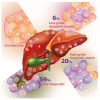Molecular Targets in Hepatocarcinogenesis and Implications for Therapy
- PMID: 30104473
- PMCID: PMC6112027
- DOI: 10.3390/jcm7080213
Molecular Targets in Hepatocarcinogenesis and Implications for Therapy
Abstract
Hepatocarcinogenesis comprises of multiple, complex steps that occur after liver injury and usually involve several pathways, including telomere dysfunction, cell cycle, WNT/β-catenin signaling, oxidative stress and mitochondria dysfunction, autophagy, apoptosis, and AKT/mTOR signaling. Following liver injury, gene mutations, accumulation of oxidative stress, and local inflammation lead to cell proliferation, differentiation, apoptosis, and necrosis. The persistence of this vicious cycle in turn leads to further gene mutation and dysregulation of pro- and anti-inflammatory cytokines, such as interleukin (IL)-1β, IL-6, IL-10, IL-12, IL-13, IL-18, and transforming growth factor (TGF)-β, resulting in immune escape by means of the NF-κB and inflammasome signaling pathways. In this review, we summarize studies focusing on the roles of hepatocarcinogenesis and the immune system in liver cancer. In addition, we furnish an overview of recent basic and clinical studies to provide a strong foundation to develop novel anti-carcinogenesis targets for further treatment interventions.
Keywords: NF-κB; hepatocarcinogenesis; inflammasome; liver cancer.
Conflict of interest statement
The authors declare no conflict of interest.
Figures



Similar articles
-
Hydrogen-Rich Saline Attenuated Subarachnoid Hemorrhage-Induced Early Brain Injury in Rats by Suppressing Inflammatory Response: Possible Involvement of NF-κB Pathway and NLRP3 Inflammasome.Mol Neurobiol. 2016 Jul;53(5):3462-3476. doi: 10.1007/s12035-015-9242-y. Epub 2015 Jun 20. Mol Neurobiol. 2016. PMID: 26091790
-
Crosstalk Between Peroxisome Proliferator-Activated Receptor Gamma and the Canonical WNT/β-Catenin Pathway in Chronic Inflammation and Oxidative Stress During Carcinogenesis.Front Immunol. 2018 Apr 13;9:745. doi: 10.3389/fimmu.2018.00745. eCollection 2018. Front Immunol. 2018. PMID: 29706964 Free PMC article. Review.
-
Liuweiwuling tablets attenuate BDL-induced hepatic fibrosis via modulation of TGF-β/Smad and NF-κB signaling pathways.J Ethnopharmacol. 2018 Jan 10;210:232-241. doi: 10.1016/j.jep.2017.08.029. Epub 2017 Aug 31. J Ethnopharmacol. 2018. PMID: 28864168
-
Insights on biology and pathology of HIF-1α/-2α, TGFβ/BMP, Wnt/β-catenin, and NF-κB pathways in osteoarthritis.Curr Pharm Des. 2012;18(22):3293-312. doi: 10.2174/1381612811209023293. Curr Pharm Des. 2012. PMID: 22646092 Review.
-
Peruvoside targets apoptosis and autophagy through MAPK Wnt/β-catenin and PI3K/AKT/mTOR signaling pathways in human cancers.Life Sci. 2020 Jan 15;241:117147. doi: 10.1016/j.lfs.2019.117147. Epub 2019 Dec 9. Life Sci. 2020. PMID: 31830480
Cited by
-
SLC39A1 Overexpression is Associated with Immune Infiltration in Hepatocellular Carcinoma and Promotes Its Malignant Progression.J Hepatocell Carcinoma. 2022 Feb 15;9:83-98. doi: 10.2147/JHC.S349966. eCollection 2022. J Hepatocell Carcinoma. 2022. PMID: 35211427 Free PMC article.
-
Viral oncogenesis in cancer: from mechanisms to therapeutics.Signal Transduct Target Ther. 2025 May 12;10(1):151. doi: 10.1038/s41392-025-02197-9. Signal Transduct Target Ther. 2025. PMID: 40350456 Free PMC article. Review.
-
Demystifying the manipulation of host immunity, metabolism, and extraintestinal tumors by the gut microbiome.Signal Transduct Target Ther. 2019 Oct 12;4:41. doi: 10.1038/s41392-019-0074-5. eCollection 2019. Signal Transduct Target Ther. 2019. PMID: 31637019 Free PMC article. Review.
-
Dysregulation in the microbiota by HBV and HCV infection induces an altered cytokine profile in the pathobiome of infection.Braz J Infect Dis. 2025 Jan-Feb;29(1):104468. doi: 10.1016/j.bjid.2024.104468. Epub 2024 Nov 28. Braz J Infect Dis. 2025. PMID: 39608222 Free PMC article. Review.
-
Modulation of the TGF-β signaling pathway by long noncoding RNA in hepatocellular carcinoma.Biomark Res. 2020 Dec 1;8(1):70. doi: 10.1186/s40364-020-00252-x. Biomark Res. 2020. PMID: 33292618 Free PMC article. Review.
References
Publication types
LinkOut - more resources
Full Text Sources
Other Literature Sources
Miscellaneous

